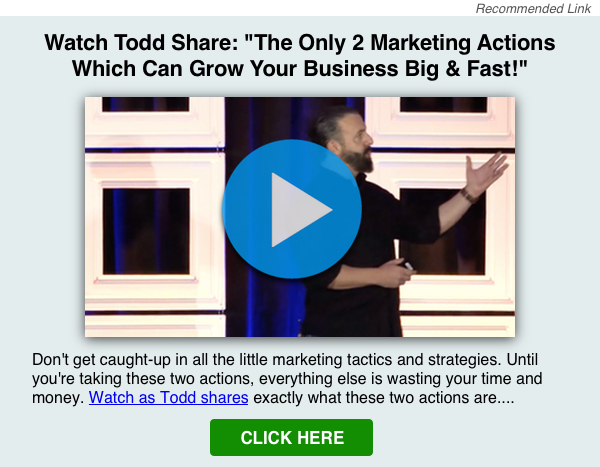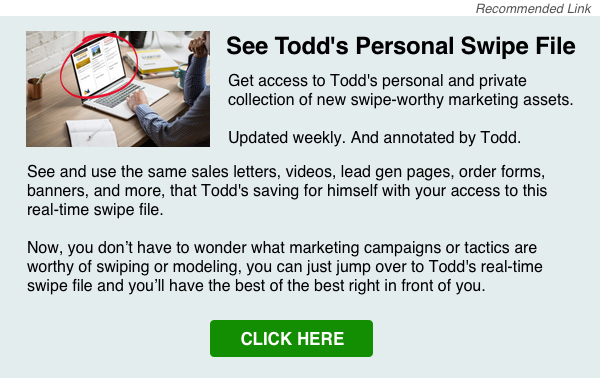Damian’s Note:
As always, Todd’s approach goes beyond the basic ideas about pricing. I think this will bring you some needed clarity and insight on what’s best for your marketing.
Damian:
There seems to be a pretty feisty on-going debate about this. I’d love to hear your thoughts.
Todd: Yeah, this discussion has been raging since I can remember. The issue lies in the fact that there is no one universally correct answer. Which approach someone should take depends on a few things.
First, it’s important to recognize:
While it’s easier to generate higher sales conversions with a lower price offer, it’s harder to make the economics work with a lower price offer when buying traffic.
So, while it’s possible to see 4-7% sales conversions with a lower priced offer, even at that rate it’s extremely difficult to recoup all of your traffic generation costs. Even with an upsell sequence in place.
Whereas, with a higher price offer, you’ll almost always have a much lower sales conversion rate, yet it’s easier to make the economics work.
Meaning: With a higher price offer, even at .05-1% sales conversion rate, it’s much easier to recoup your traffic generation costs. Even without having any upsells.
Damian: But everyone is focused on sales conversions. So doesn’t that make the lower price offer the way to go?
Todd: Not necessarily. First off, remember, you can’t deposit sales conversion rate. You can only deposit ROI (return on investment).
Sales conversion rate is simply a metric for optimizing a marketing campaign. It doesn’t tell you the viability of a marketing campaign.
You can have a 10% sales conversion rate and be losing money. Or, you can have a .05% sales conversion rate and be profiting on day one.
That’s why you need to go deeper.
Damian: What do you mean?
Todd: It depends on the maturity of the business.
New entrepreneurs with a new business need to be able to recoup 100% of their traffic buying costs as fast as possible. They can’t afford to spend, say, $50 to acquire a new customer who only spends $30 with them on day one. If they do, they’ll likely run out of money.
For these folks fast ROI is the name of the game.
For veteran entrepreneurs with a mature, cash-flow positive business, the name of the game is acquiring as many new customers as possible with each marketing campaign.
So, these folks don’t need to focus on instant ROI. They can afford to acquire more new customers without recouping all of their traffic costs right away.
Meaning: They can afford to go negative (i.e. spend more to get a customer today than what that customer spends today… based on the value of future transactions).
Damian: So how does this effect which pricing model they each should be using?
Todd: Well, since a lower price offer usually doesn’t recoup 100% of traffic costs right away, but brings in many more customers than a higher price offer, it’s more suited for a mature business.
Mature businesses can afford to use campaigns with “weaker” day one economics. Because they have the cash to float until they get to breakeven then profitable.
Whereas, since a higher price offer can often recoup 100% of traffic costs even with a low sales conversion rate and no upsells, it’s better suited for an early-stage business.
A higher price offer won’t bring in the same quantity of new customers as a lower price offer will, but it gives the newer business a much better shot at quickly recouping their traffic costs.
Damian: And is there ever a time where an entrepreneur would use both approaches in two different campaigns?
Todd: Absolutely. For a mature business, any campaign that acquires new customers at or below the “appropriate cost” (i.e. maximum allowable acquisition cost), is a viable campaign.
For less mature businesses, I’d stick to a higher price strategy to recoup my traffic costs right away.
Then, once I have the extra cash flow and know my lifetime customer value (i.e. value of future transactions), I can get more aggressive with what I’m spending to acquire a new customer… by using lower price offers.
Make sense?
Damian: Absolutely. Really appreciate you taking the time to share your thoughts, Todd. As always, really insightful.
Todd: My pleasure.



